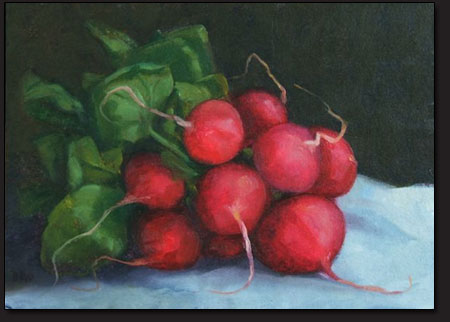|
| ||
| Radish Cookery
by Ari LeVaux Posole, a hominy and chile stew that’s ubiquitous in New Mexico, has deep roots south of the border, where it’s a celebratory dish often served at Christmas. When most people think Christmas, they think Dec. 25. But in New Mexico, Christmas has a different meaning, one that’s holier than shopping, vacation and sometimes even Jesus. New Mexico’s version of Christmas is rooted in a question: “Red or Green?” The query concerns the color of chile sauce you want on your food – be it eggs and toast, burgers and fries, burritos, enchiladas, samosas, fish, chicken, steak, chicken-fried steak…anything. It’s a question that can trap even seasoned menu black-belts like myself in an existential bind. Sometimes the solution to this dilemma is to say “Christmas,” which means you want both red and green. Red sauce is usually made with garlic, oregano and red chile, while green sauce is roux-based, with green chile. Red and green chiles come from the same plant; the color difference is based on when the chile is harvested, and how it’s processed. Greens are harvested mid-to-late summer, when they’re still green, and then flame-roasted. The roasting loosens the skin and releases a smoky, addictive flavor capable of wilting any green aficionados within smelling distance. Roasted greens are typically preserved by freezing or canning. Red chiles are allowed to fully ripen to a deep red color, and are strung-up and sun-dried. Red chile is thin-skinned compared to its fleshy green cousin, and has a sweeter heat. Posole can be made with either red or green chile, though red is more common. I prefer cooking my posole with red chile and then adding chopped green – not the sauce, just the chile – to the bowl at serving time, for a variation on Christmas. Hominy, the heart of posole, is a large-kernelled corn that’s been dried and then soaked in lye-water. This process, which first appeared in present-day Guatemala more than 3,000 years ago, spread to much of the native American world – as far as the Cherokee Nation in the southeastern United States. The treatment removes the germ and hard outer hull from the kernels, adds calcium, makes the corn more palatable and easier to digest, converts niacin into a form more easily absorbed by the body, and improves the availability of some amino acids. These days, hominy is widely available canned or dried. Dried is preferable – it makes a better posole and it’s cheaper, especially if you order it online (try gourmetsleuth.com). Hominy was traditionally made with white corn, but today it’s available in yellow and blue as well. If you can get more than one color hominy, by all means mix them up in your posole. Most feast dishes tend to be elaborate, labor-intensive, and expensive affairs. Posole is none of these. Nonetheless, I’m going to complicate things a bit by giving you some options for different variations. Whatever path you choose, in the end the process simmers down to little more than putting the ingredients in a pot and cooking them slowly. To make four generous servings, use two cups of dried hominy, or four cups of canned. Dried hominy should be rinsed; canned should be drained. I make posole with dried hominy, in a crock pot on high for eight hours. You can also soak dried kernels for 24 hours with a lime squeezed in, drain and rinse, then proceed on the stovetop. The stovetop protocol works for canned hominy, too. Two cups of dried hominy should be cooked in five quarts of water; four cups of canned need only four quarts of water. The red chile can be added in powdered or whole form, in quantities according to your tolerance for heat. I use a combination of three tablespoons powdered red chile and five whole reds. Break open the dried whole chiles and remove the seeds and stems. Hand-crush them into large fragments and add them to the pot. Add two tablespoons oregano, preferably Mexican rather than the Mediterranean varieties, and a whole mess of chopped garlic. Posole is usually made with pork shoulder, but I prefer red meat like beef, lamb, goat, or elk. Whichever you preference, pan-brown a pound or two of trimmed meat cut into inch-cubes. Once browned, add a chopped onion, or two, or five. Make sure to savor the smell of raw onion cooking into the browned meat. Kill the heat when the onion starts to sweat. Add the meat and onions to the pot, and season with salt or garlic salt—depending on how much fresh garlic you added, and how much you like garlic. Since this is going to cook for hours, it’s good to start small with the oregano and the salt. Taste and re-season as you go. Some people like to add sage, cumin, or even cinnamon. I’d recommend using just oregano in your first batch, and expanding your horizons from there. Cook on low/medium heat until the hominy is soft – about 8 hours with dried hominy, and 2 hours with canned or soaked. If you don’t have any roasted green chile from last summer in your freezer, then roast five or six fresh Anaheim chiles, or similar variety, under the broiler until the skins blister. Remove the skins, stems and seeds under running cold water and chop the chiles. Add a tablespoon or two of chopped green chile to your red chile posole, serve with garnish plate of limes and fresh aromatic veggies like sliced radish, cabbage and cilantro, and let me be the first to wish you “Feliz Navidad” from New Mexico, where every day can be Christmas. And while purists might shudder, I should mention that I also like a dab of mayo in my posole. White Christmas, anyone? •
|


